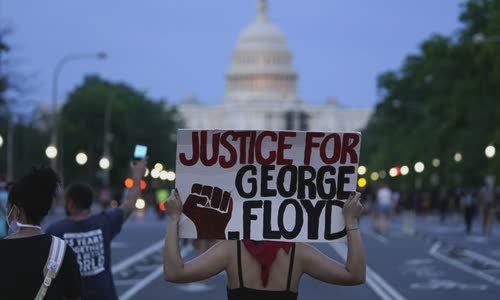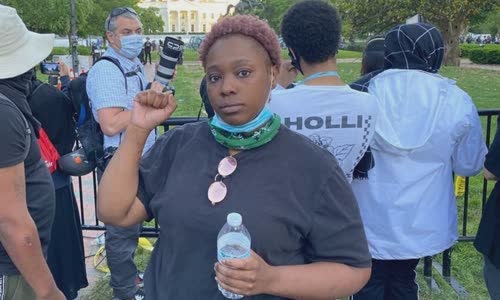The protest movement was initially chaotic, but now it is starting to become more organized.
Vanjalic Tolbert previously wanted to become a police officer.

Protesters raise banners for justice for George Floyd on Pennsylvania Avenue in Washington DC, USA, May 29 Photo: AP.
On the evening of May 31 in the capital, Tolbert stood in the middle of Lafayette Square screaming in front of a long line of military police officers standing between her and the White House.
"You guys got this job to make the streets better so why are you the people we are afraid of now?" Tolbert shouted at the police.
A few meters away, the Hay-Adams hotel was surrounded by plywood after it was vandalized the night before.
"I have to try very hard to be able to protest peacefully," Tolbert said.
May 31 evening protests proved it was more dangerous than the night before.
The chaotic night outside the White House marks the beginning of one of the most turbulent and turbulent weeks in modern American history.
Adriane Lentz-Smith, an expert on African-American history at Duke University, North Carolina, thinks that the protests are going on, the way protesters express anger and pain is not new but it
According to her, the video recorded nearly 9 minutes of Floyd being pinned by police officer Derek Chauvin on the back of the neck on May 25, leading to death as a "fuse sparking an angry flare" after a series of recent demoralizing events.
During this period, the United States was shocked at the video of young black man Ahmaud Arbery being shot dead by two white men in Georgia while he was walking out.
Since the beginning of March, most Americans have been living under a blockade, they crave social connection outside of family and friends.
"I feel desperate at home so I need to come," James Toom, 46, said at a rally in Washington last week.
On June 1, after the night of protests outside the White House, hundreds of protesters continued to gather at Lafayette Square.
He threatened to activate the Revolt Act of 1807 and declared: "If any city or state refuses to take the necessary actions to protect people's lives and property, I will mobilize the US military and
During Trump's speech, riot police unexpectedly moved to dismiss protesters in Lafayette Square violently.

Vanjalic Tolbert protests outside the White House Photo: SMH.
Democrats are angry at the announcement from the White House boss.
But more abnormally, some senior military leaders and Trump's cabinet members have also expressed concern over the action from the President.
Former Defense Secretary James Mattis criticized.
"I think General Mattis's words are accurate, honest, necessary and timely," said Alaska Sen. Lisa Murkowski.
In the following days, the protests in Washington continued to become tense.
Bob Stimpson, 73, a retired principal, drove a four-hour drive from his home town of Virginia to Washington to participate in the protest.
"When I saw the President order tear gas at protesters so he could stand in front of the church, I knew I needed to do something," Stimpson said.
Upon arrival, Stimpson realized that the city had been highly militarized.
By the middle of the week, the protests were bigger but more peaceful.
Protesters were more satisfied when Minnesota Attorney General Keith Ellison announced on June 3 that he had raised charges against police officer Chauvin from level three murder to second degree murder, and further prosecution.
Throughout the country, protests are becoming increasingly diverse.
Speaking at Floyd Memorial in Minneapolis on June 4, veteran civil rights campaigner Al Sharpton said Flyod's death was a metaphor for centuries of US racial and systemic discrimination.
Despite speaking at many funerals of black people killed by white police officers, Sharpton said he felt "overflowing with hope than ever before" that real change was coming.
"When I saw the protesters, in some cases, young white people outnumbered people of color, I knew this time would be different," he said.



 Erika Miller
Erika Miller







